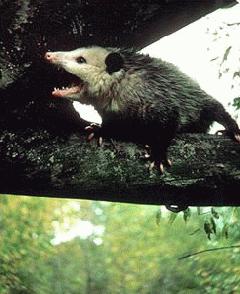Source(s): Jim Howell, Ph.D., Entomologist, The University of Georgia
Opossums are found throughout much of the United States and north into parts of Canada. Although these animals are interesting and beneficial in the wild, they can become a nuisance when seeking food or shelter in our homes or other buildings.
Description
The common opossum is a grayish-white animal with a scaly, hairless tail, a triangular shaped head with a pointed snout, and is about the size of a house cat. Males reach a length of 3 feet, including the tail, and average 6 to 12 pounds. Females are smaller and weigh about 4 to 6 pounds. Their frequent “grin” shows 50 sharp teeth, more than any other North American mammal. The opossum is the only marsupial in North America, and females, like kangaroos and koalas, carry their young in a pouch located on the front of the abdomen.
Biology
Opossums thrive east of the Rocky Mountains. They are common from Maine to Florida and have been introduced into California. Opossums, like other marsupials, give birth to relatively undeveloped young which climb into the mother’s marsupial pouch. They spend the next two months feeding on mother’s milk before emerging. There are up to three litters a year from January to July, with about six to eight young per litter. When the female leaves the den, the young opossums often ride along on her back. Opossums eat a wide range of foods, including but not limited to carrion (popularly known as road kill), grass, fruits and vegetables, insects, garbage, pet foods, snakes, chickens, and eggs.
Although their first line of defense is to hiss and bare their teeth, as a last resort they may play dead. The popular term “playing possum” comes from the opossum’s habit of dropping to the ground, opening its mouth and remaining motionless for several minutes. Many predators won’t attack a dead animal and will walk away when an opossum plays dead.
Because of their range and dietary preferences, they are sometimes a nuisance to homeowners. Because they readily eat pet foods and cultivated plants, and rumage through garbage cans, they often come into contact with humans and will readily enter dwellings through vent systems or torn screens. They may adopt a household because of the availability of food and will take up residence behind stored items in carports or beneath houses, leaving unsightly droppings along with an unpleasant odor.
Control
Live traps can be used to capture opossums. Cat food, apples or sardines make good bait. Once captured, a problem arises: what to do with the critter? Relocation may work if you are sure you are not creating another problem in the release area. Local ordinances should be checked for restrictions on capture and release efforts. Most counties recognize these creatures as game animals, but local regulations should be consulted before treating them as such.
Center Publication Number: 235
- Icky Silverfish are Generally Harmless - September 24, 2013
- Menacing Mice - September 24, 2013
- Opossum Damage and Control - September 24, 2013